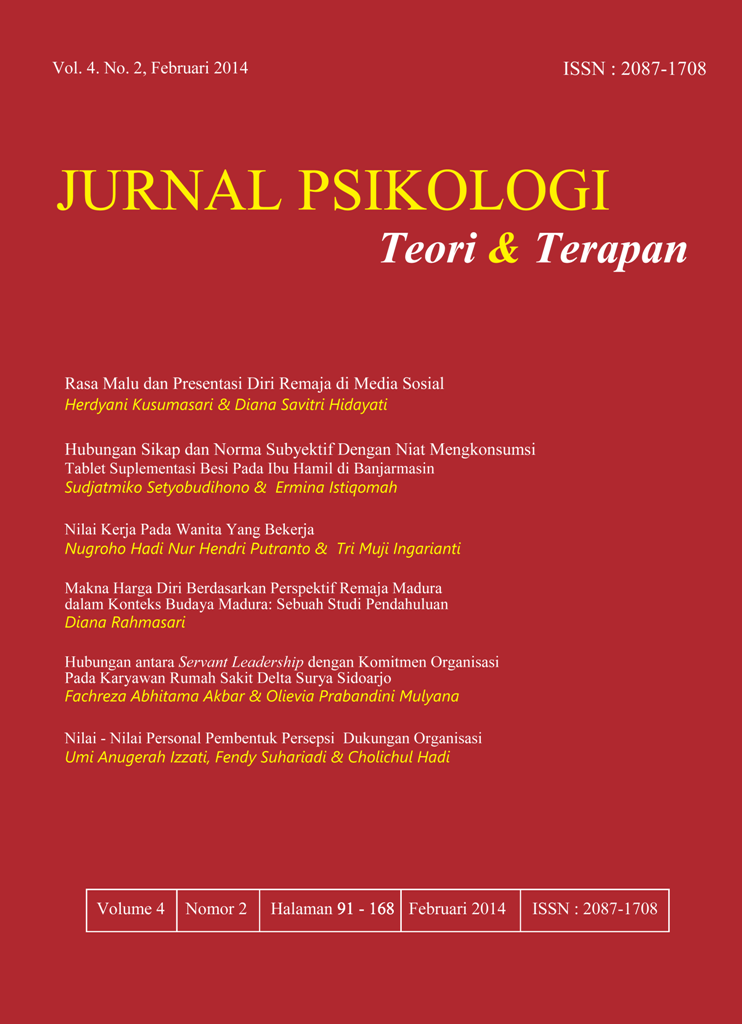NILAI KERJA PADA WANITA YANG BEKERJA
DOI:
https://doi.org/10.26740/jptt.v4n2.p113-129Keywords:
Nilai Kerja, wanita bekerjaAbstract
Value can be defined as the work the general belief about the desirability of various aspects of employment (eg, salary, autonomy, working conditions), and work-related outcomes (eg, achievement, fulfillment, prestige). It's important to note that the value of the work did not evaluate certain aspects of the work or the result, but the underlying criteria used to perform the evaluation. This study used a non-experimental method which quantitative descriptive approach wich aims to reveal the value of labor in women who work. The research sample of 100 women who worked in the city of Malang. With a value scale work consisting of 98 items statement, found the results of the analysis of the Z-Score with the acquisition of a percentage on each level of the value of work starting from the highest rank is the dimension of the value of autonomy (Autonomy), which is as much as 28% or 28 people, followed by value of achievement (Achievement) and the principle of putting others (Altruism) which had the same percentage as much as 20%, and the next is the value of the status (Status) with a percentage of 18%, next is the value of comfort (Comfort) with a percentage of 14%, while the lower value is the value of the security (Safety ) with a percentage gain as much as 0% .
Abstrak: Nilai kerja dapat didefinisikan sebagai keyakinan umum mengenai keinginan dari berbagai aspek pekerjaan (misalnya, gaji, otonomi, kondisi kerja), dan hasil yang berhubungan dengan pekerjaan (misalnya, prestasi, pemenuhan, prestise).Sangat penting untuk dicatat bahwa nilai kerja tidak mengevaluasi aspek pekerjaan tertentu atau hasil, tetapi kriteria yang mendasari yang digunakan untuk melakukan evaluasi tersebut. Penelitian ini menggunakan metode non eksperimental yang menggunakan pendekatan kuantitatif deskriptif yang bertujuan untuk mengetahui gambaran nilai kerja pada wanita yang bekerja. Sampel penelitian berjumlah 100 orang wanita yang bekerja di kota Malang. Dengan skala nilai kerja yang terdiri dari 98 item pernyataan, ditemukan hasil analisa Z-Score dengan perolehan prosentase pada masing-masing tingkat nilai kerja dimulai dari ranking tertinggi adalah dimensi nilai otonomi (Autonomy), yaitu sebanyak 28 % atau 28 orang, kemudian diikuti dengan nilai prestasi (Achievement) dan azas mengutamakan orang lain (Altruism) yang sama-sama memiliki prosentase sebanyak 20%, dan berikutnya adalah nilai status (Status) dengan prosentase 18%, selanjutnya adalah nilai kenyamanan (Comfort) dengan prosentase sebanyak 14%, sedangkan nilai terbawah adalah nilai keamanan (Safety) dengan perolehan prosentase sebanyak 0%.
References
Azwar, Saifuddin. (2008). Reliabilitas dan Validitas: Pustaka Pelajar.
Baruch, Yehuda. (2004). Managing Careers. Glaslow: Bell And Baind Limited.
BLS Spotlight On Statistics: Women At Work (2011). http://www.bls.gov/spotlight/2011/women at work.
D
awis, Rene V., & Lofquist, Lloyd H. (1984). A Psychological Theory Of Work Adjustment: An Individual-Differences Model and Its Applications. Minneapolis: University of Minnesota Press.
D
ayakisni, T., & Yanuardi, S. (2004). Psikologi Lintas Budaya. Malang: UMM Press.
Hansen, Jo-Ida C., & Leuty, Melanie E. (29 August 2011). Work Values Across Generations. Journal of Career Assessment from http://jca.sagepub.com/content/20/1/34.
Leung, S. Alvin (2008). International Handbook of Career Guidance: The Big Five Career Theories. China: The Chinese University of Hong Kong.
McCloy, Rod., Waugh, Gordon., Medsker, Gina. (1999). Main Study: Relationships of Work Values with Gender, Race/Ethnic Group, and Education.National Center for O*NET Development Employment Security Commission.
Perempuan dalam dilemma pengasuhan anak pekerjaan. (2011, 06 April). http://kompasiana.com/ibu-dan-anak/2011/04/06/perempuan-dalam-dilemma-pengasuhan-anak-pekerjaan.
Santrock, John W. (2002). Life-Span Development: Perkembangan Masa Hidup, Edisi 5, Jilid II. Jakarta: Erlangga.
Weiss, David J., Dawis, Rene V., England, George W., & Lofquist, Lloyd H. (April, 1964). Minnesota Studies In Vocational Rehabilitation: XVI - The Measurement Of Vocational Needs. Minneapolis: University of Minnesota Press.
Weiss, David J., Dawis, Rene V., England, George W., & Lofquist, Lloyd H. (December, 1964). Minnesota Studies In Vocational Rehabilitation: XVIII Construct Validation Studies Of The Minnesota Importance Questionaire. Minneapolis: University of Minnesota Press.
Winarsunu, T. (2009). Statistik, Dalam Penelitian Psikologi & Pendidikan. Malang: UMM Press.
Winter, David. Theory of work adjustment. Careers Group, University of London (www.careers.lon.ac.uk) from http://creativecommons.org/licenses/by-nc/2.0/uk/
Downloads
Published
How to Cite
Issue
Section
License
Authors who publish in this journal agree to the following terms:
Copyright in any article is held by the author.
The author grants the journal, publication rights with the work simultaneously licensed under a Creative Commons Attribution License that allows others to share the work with an acknowledgment of the work's authorship and initial publication in this journal.
Authors may enter into separate, additional contractual arrangements for the non-exclusive distribution of the journal's published version of the work (e.g., posting it to an institutional repository or publishing it in a book), with an acknowledgment of its initial publication in this journal.
Authors are permitted and encouraged to post their work online (e.g., in an institutional repository or on their website) prior to and during the submission process, as this can lead to productive exchanges, as well as earlier and greater citation of published work.
 Abstract views: 2431
,
Abstract views: 2431
, PDF Downloads: 2159
PDF Downloads: 2159


















